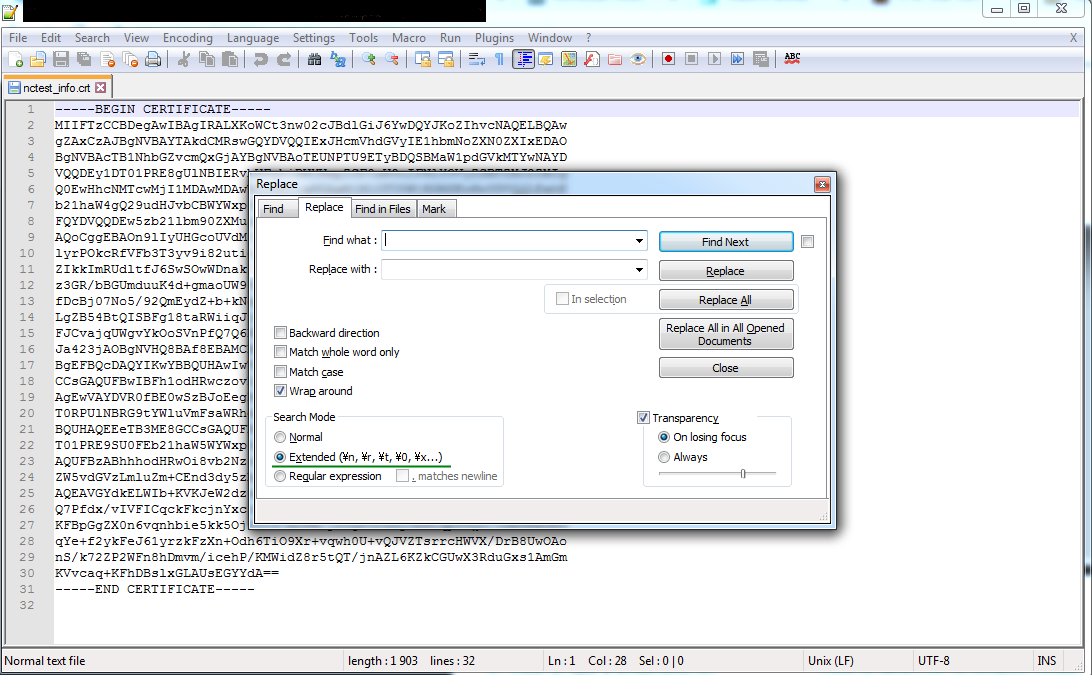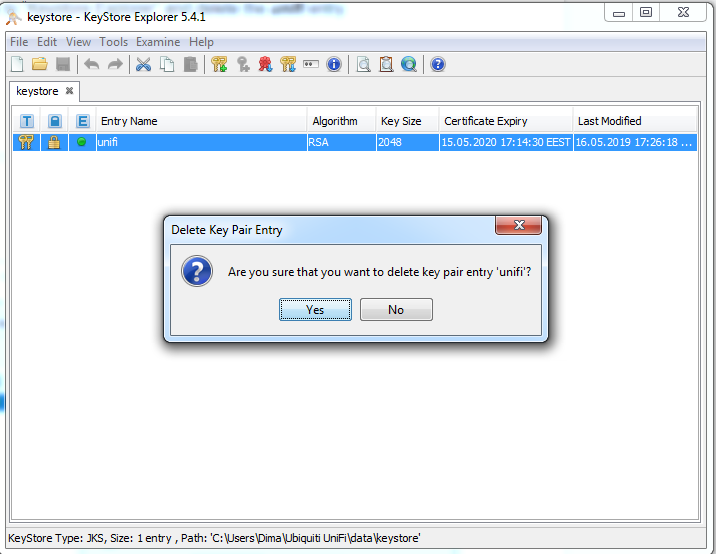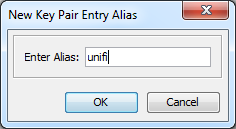Com Apple Ubiquity Ssl Cert
Installing an SSL document on Ubiquiti Unifi
Official documentation for the UniFi controller includes one method of installing an SSL. This method is relatively unproblematic; however, there is a mutual issue involving an error bulletin that doesn't indicate the actual root. This guide outlines diverse culling installation methods, shows how to fix common errors, and provides useful security enhancement tips. unifi-os stop unifi-bone restart Please note, that the role /etc/ssl/private/unifi.keystore.jks should be replaced with the path to your new Keystore where the new document files are located. This method is more often than not recommended, although it has some peculiarities, so information technology isn't ever the most reliable. The certificate should be installed in the folder where the CSR code was generated. Follow the steps below to complete the SSL installation using ace.jar: Important: Brand certain to start the application with administrator rights on Windows. To do this, right-click on the program icon and choose the Run as administrator pick or do it this mode: On Linux/MacOS, you should have root or sudo user access. For this, run the following command: sudo su - To start the installation, open the UniFi shell to access the UDM files: unifi-bone shell cd Use the following command: java -jar lib/ace.jar import_cert *your certificate*.crt SectigoRSADomainValidationSecureServerCA.crt USERTrustRSAAddTrustCA.crt addtrustexternalcaroot.crt Where *your certificate* is replaced with your actual file proper name. If you received the intermediate and root certificates in i arranged file (.ca-parcel), you tin download them separately here. Note: that the example command above contains intermediate certificates for the standard Domain Validation type SSL. Go along in heed that some server versions may require the whole CA Package to be uploaded as a single file. In such a example, y'all can download the respective bundle following the instructions in this commodity and use the following command: java -jar lib/ace.jar import_cert *your certificate*.crt package.crt unifi-os restart Y'all can check the installation here. Important : In that location is a known problems on some mutual modern UniFi versions: after importing the files to the server, the mistake, "Unable to import the certificate into keystore" appears. This is because on some UniFi versions, ace.jar is unable to parse the new string (\due north) symbol. On Linux and MacOS, this issue tin exist resolved by removing these symbols with a elementary command: tr -d '\n\r' < *file proper name* > *temporary file name* && mv *temporary file proper noun* *file name* Solution : Supersede the *file name* with the actual proper name of the required file. Apply the command to your certificate, to each of the intermediate certificates, and the root certificate. The *temporary file name* value is required as a temporary file considering the command does not allow it to salve the modified content in the same file directly. Therefore it'south necessary to salvage it in a temporary identify and then replace the former one with it. Alternatively, you can employ this control: tr -d '\northward\r' < *file proper name* | echo $(cat -) > *file name* On Windows, the certificate files can be fixed past using Notepad++: Inside the keystore, import the file in the PKCS#vii format (with a .p7b or .cer extension). Follow Steps 1-3 in the Standard ace.jar method. Save the certificate's Private central to the /data/keystore file in the default UniFi keystore afterwards you generate the CSR code. keytool -import -trustcacerts -alias unifi -file *your certificate*.p7b -keystore /data/keystore Enter the keystore password "aircontrolenterprise" (unless it was inverse in your UniFi settings) and press Enter to complete the import. unifi-os restart And at present yous're done! Yous tin can cheque the installation hither. Warning: You may receive the error "Input not an 10.509 document" while importing the SSL in the PKCS#7 format. It may exist related to the extra empty strings in the file or other formatting issues. If editing the file in a text editor does not aid, importing the SSL as PEM files is best. On Windows, you can also utilise this solution: Alternatively, you can import the SSL file in PEM format (.crt). The example below uses files for a Domain Validation certificate. The procedure is similar for other SSL types. Find the respective files here. keytool -import -trustcacerts -alias root -file addtrustexternalcaroot.crt -keystore /data/keystore keytool -import -trustcacerts -alias intermediate2 -file USERTrustRSAAddTrustCA.crt -keystore /information/keystore keytool -import -trustcacerts -alias intermediate1 -file SectigoRSADomainValidationSecureServerCA.crt -keystore /data/keystore keytool -import -trustcacerts -allonym unifi -file *your document*.crt -keystore /information/keystore PLEASE Annotation TIP unifi-os restart The files are the same as for the Standard installation method with ace.jar. You lot tin can apply this option if the CSR was generated elsewhere or the OpenSSL method was used instead of the default UniFi tool during the procedure. In this instance, a private central (.cardinal) is created separately. You need to import the central file into the keystore along with the certificate (.crt) and chain (.ca-parcel ) files. Steps 1-iii are the aforementioned as in the Standard method with ace.jar. If you prefer carrying out the process through control line, follow these steps : Technically, you can put them in dissimilar folders; if you lot do, add the full paths to the files in the commands in the post-obit steps where these files are used. openssl pkcs12 -consign -out *your certificate*.pfx -inkey *your document*.key -in *your certificate*.crt -certfile *your certificate*.ca-package -proper noun "unifi" keytool -importkeystore -srckeystore *your certificate*.pfx -srcstoretype PKCS12 -destkeystore /data/keystore -deststoretype jks -deststorepass *password* Replace the *password* value with your bodily password for the UniFi keystore. unifi-os restart If you lot adopt generating the PFX elsewhere (e.g. our converter), exercise the following : keytool -importkeystore -srckeystore *your certificate*.pfx -srcstoretype pkcs12 -srcalias 1 -destkeystore /information/keystore -deststoretype jks -destalias unifi -deststorepass *password* PLEASE NOTE: For the PFX file without an alias assigned, ane is used as the default alias. Also, ensure you include -srcalias and -destalias in the command to avoid the mistake, "Allonym unifi does non exist". The *password* value should be replaced with your actual password for the UniFi keystore. unifi-os restart There is a small-scale chance that the default allonym is different. If you encounter an error, you can check the alias with any of the following commands: openssl pkcs12 -in *your certificate*.pfx -info keytool -list -storetype pkcs12 -keystore *your certificate*.pfx -v For UDM-pro you just need to replace the default private key and self-signed certificate and restart UDM. Settings >> Network Settings >> Device Hallmark >> Plough it on and ready up the username and password (or generate an admission key, which is an alternative option that you will be offered at the final step). cd /mnt/data/unifi-os/unifi-core/config/ At that place are two files inside the folder: unifi-core.crt and unifi-core.key . These are a self-signed certificate and a Private key, respectively. To install the valid SSL they should be replaced with an actual certificate received from the CA and a corresponding Individual key Y'all can combine the .crt and .ca-bundle files y'all received from the CA in multiple ways: cat example.crt >> unifi-cadre.crt ; repeat >> unifi-core.crt ; cat example.ca-bundle >> unifi-core.crt To open up information technology in the command line, use whatsoever provided Linux editor like nano or vi (for example, run nano unifi-cadre.crt ). unifi-os restart All installation methods described for UDM-base work similarly on older UniFi controller versions. However, a few methods cannot be used for UDM even though they were valid in the past. They are described below. The process is generally the same every bit on Linux: yous upload the files to the server and run the keytool commands to install them in the keystore. However, there is one difference. Different Linux-based servers, Windows requires a full path to exist specified when you are running an awarding. Because keytool.exe, certificate files, and the keystore may be located in dissimilar folders, make certain to use the full path unless the file is in the folder where y'all run the command. To import the files in the PKCS#7 format by running this command: "*Java base folder*\bin\keytool.exe" -import -trustcacerts -allonym unifi -file *your certificate*.p7b -keystore "C:\Users\*account username*\Ubiquiti UniFi\information\keystore *Java base folder* is specified during the Java installation on the server. By default, it is something like "C:\Program Files\Java\*Coffee version*\". Alternatively, run the control below to switch to the Coffee base binder: cd *Coffee base binder* keytool -import -trustcacerts -alias unifi -file "C:\Users\*account username*\Ubiquiti UniFi\*your document*.p7b" -keystore "C:\Users\*account username*\Ubiquiti UniFi\data\keystore" If UniFi is configured as a Windows service, run these commands: net stop "UniFi Controller" The certificate should now exist installed. Importing PEM certificates tin be performed equally described in the Importing PEM department, specifying the full path to the files in all commands. The easiest way to import the PFX on UniFi on Windows is with the assistance of "Keystore Explorer". (It can also exist used for Linux/Mac Bone, though it is best suited for Windows). TIP: You lot tin open the system.backdrop file and add together your custom countersign to it: Choose your own password for this. It can be dissimilar from the password used in the UniFi controller. There, locate your PFX file and utilise the countersign you set during its creation. Restart the controller to use the changes. On Linux: On Windows, shut the UniFi application and offset it again using the application icon or, if UniFi is configured as a Windows service, use the commands: net end "UniFi Controller" WARNING: Sometimes, the keystore may get corrupted because of multiple imports. If the process does not work properly, delete the initial keystore file and restart UniFi to create a new one, and only proceed with the PFX import when this is done. This process is similar to installation on Linux. The PFX file can exist generated past doing the following: certutil -mergepfx *your document*.p7b *your certificate*.pfx Alternatively, you tin put the certificate, private cardinal and CA-bundle in one folder and generate it with OpenSSL: Default OpenSSL path on Windows (if you accept it installed) is "C:\*OpenSSL version*\bin\OpenSSL.exe". "*Java base folder*\bin\keytool.exe" -importkeystore -srckeystore *your document*.pfx -srcstoretype pkcs12 -srcalias one -destkeystore "C:\Users\*account username*\Ubiquiti UniFi\information\keystore" -deststoretype jks -destalias unifi -deststorepass *password* *Java base folder* is specified during the Java installation on server. Past default, it is something like "C:\Program Files\Coffee\*Java version*\". net cease "UniFi Controller" The SSL should at present be installed. The following list includes features not directly related to SSL setup simply related to site security and different ways to configure it. Uncomment the corresponding (to a higher place-mentioned) strings, relieve the file, and restart UniFi to complete the process. Permitted nil suites and SSL/TLS versions can be enabled on UniFi in the system.backdrop file using the following parameters: Uncomment the respective (above-mentioned) strings, save the file, and restart UniFi to consummate the procedure. Check the optimal configurations for UniFi here.
Unifi Dream Auto (UDM) is the latest version of network management hardware created by UniFi. It unremarkably comes with UniFi OS (a version of a Debian-based Linux Operating System). It has two variations: UDM-base, which is technically a modification of older UniFi controllers, and UDM-Pro, which has its own graphical interface for added ease of use. Installing SSL on UDM-base
Important note: Sometimes, a default certificate on the server might be used instead of the i yous install, which may cause security warnings in browsers. To avoid this outcome, regardless of what installation method you apply, please consummate the below steps first:
rm /usr/lib/unifi/information/keystore && cp /etc/ssl/individual/unifi.keystore.jks /usr/lib/unifi/data/keystore
UNIFI_SSL_KEYSTORE=/etc/ssl/private/unifi.keystore.jks Standard method with ace.jar
Properties >> Compatibility >> mark the Run this program every bit an ambassador >> OK.


Installation with keytool
Importing PKCS7
TIP: Within the Internet Explorer browser, click on Tools >> Internet Options to install it.
TIP: Yous can salvage the file with a .cer extension.Importing PEM
PFX file import via command line
Installing SSL on UDM-pro
SSL installation for UniFI services non based on UDM
Installation with keytool (for Windows)
Shut the UniFi application and offset information technology once more using the application icon.
net start "UniFi Controller" PFX file import using Keystore Explorer
The file is located in the in the data subfolder of UniFi base folder.


service unifi restart
net start "UniFi Controller" PFX file import (Windows) via command line
*OpenSSL path* pkcs12 -export -out *your document*.pfx -inkey *your certificate*.key -in *your certificate*.crt -certfile *your certificate*.ca-bundle -proper noun "unifi"
cyberspace start "UniFi Controller" Unify SSL security features
This option works on all UniFi versions starting from 4.x.unifi.https.hsts=false - set to true to enable HSTS
unifi.https.hsts.max_age=*value* - you lot can specify the duration for how long HSTS is cached (in seconds)
unifi.https.hsts.preload=imitation - set to truthful only if yous practice not plan to remove the HSTS, as information technology will add your UniFi hostname to the preload list, deletion from which should be requested specifically
unifi.https.hsts.subdomain=false - fix to true if you lot would like to use an HSTS policy for the subdomains of your domain name, also as for the main domain proper name
unifi.https.ciphers=cipher1, cipher2, etc. - replace the values with the actual naught names y'all want to enable
unifi.https.sslEnabledProtocols=protocol1, protocol2, etc. - supervene upon the values with the actual protocol names y'all want to enable
Associated articles
Com Apple Ubiquity Ssl Cert,
Source: https://www.namecheap.com/support/knowledgebase/article.aspx/10134/33/installing-an-ssl-certificate-on-ubiquiti-unifi/
Posted by: porternoust1988.blogspot.com


0 Response to "Com Apple Ubiquity Ssl Cert"
Post a Comment